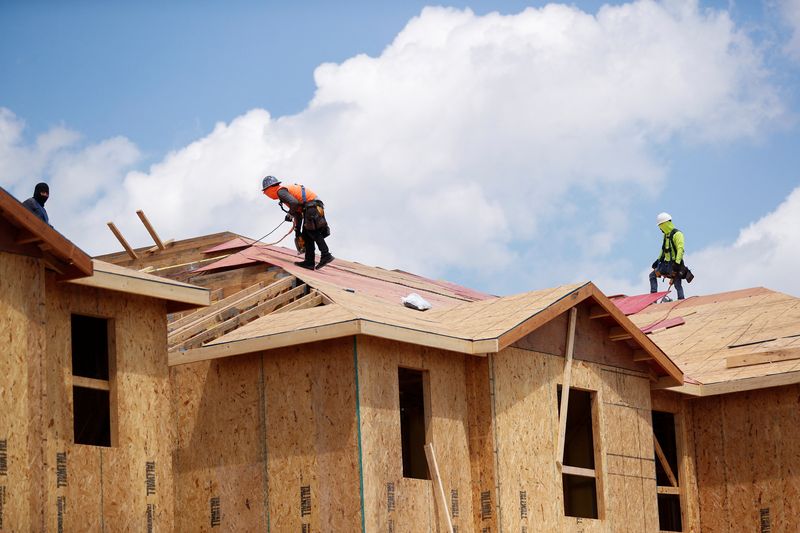By Lucia Mutikani
WASHINGTON (Reuters) -Confidence among U.S. single-family homebuilders slipped in January after four straight monthly increases, and builders called for a new softwood lumber agreement with Canada to ease shortages and lower prices, a survey showed on Tuesday.
Other data showed factory activity in New York state slumped this month amid surging COVID-19 infections, but manufacturers remained upbeat about business conditions over the next six months. The reports supported views that the economy started the year on a soft note because of high inflation, shortages and raging coronavirus cases, driven by the Omicron variant.
"This is a reminder that COVID still holds sway over the recovery," said Oren Klachkin, lead U.S. economist at Oxford Economics in New York. "U.S. supply chain dynamics didn't improve at the end of 2021, and early data suggest they've only worsened in 2022."
The National Association of Home Builders/Wells Fargo Housing Market index dipped one point to 83 this month. A reading above 50 indicates that more builders view conditions as good than poor.
"NAHB analysis indicates the aggregate cost of residential construction materials has increased almost 19% since December 2021," NAHB Chairman Chuck Fowke said in a statement. "Policymakers need to take action to fix supply chains. Obtaining a new softwood lumber agreement with Canada and reducing tariffs is an excellent place to start."
According to the NAHB, higher material costs and shortages were adding weeks to typical single-family home construction times. The economy is struggling with high inflation, mostly the result of the pandemic, which has snarled supply chains.
The United States last November nearly doubled the duties on imported Canadian softwood lumber to 17.9% after a review of its anti-dumping and countervailing duty orders.
The Trump administration initially imposed 20% duties on Canadian softwood lumber in 2018 after the collapse of talks on a new quota arrangement, but reduced the level in December 2020 to 9%. President Joe Biden's administration had stuck to those duties until the Commerce Department's November review.
The NAHB survey was conducted during the first two weeks of January and does not fully reflect the recent jump in mortgage interest rates. The 30-year fixed-rate mortgage averaged 3.45% during the week ending Jan. 13, up from 3.22% in the prior week, according to data from mortgage finance agency Freddie Mac (OTC:FMCC).
More expensive building materials and higher mortgage rates could make housing less affordable, especially for lower-income groups and first-time home buyers.
The dollar was trading higher against a basket of currencies. U.S. Treasury yields rose, weighing on Wall Street stocks.
THE OMICRON EFFECT
The NAHB survey's measure of current sales conditions was steady at 90, but its gauge of sales expectations over the next six months dropped two points to 83. The component measuring traffic of prospective buyers also fell two points to 69.
A separate report from the New York Federal Reserve on Tuesday showed its "Empire State" index of current business conditions plunged 32.6 points to a reading of -0.7 this month. This was the first negative reading since June 2020.
A reading below zero signals a contraction in the New York manufacturing sector. New York has been slammed by a vicious winter wave of coronavirus infections which has severely disrupted business activity. The survey offered an early read of Omicron's impact on the economy. There are signs that infections have peaked in some regions, including New York.
"It is possible that the recent weakening is related to the surge in virus spread over the past several weeks and/or persisting supply issues and price pressures," said Daniel Silver, an economist at JPMorgan (NYSE:JPM) in New York. "We will see if other January manufacturing surveys released this week and beyond reinforce the downbeat message from the Empire State survey."
Manufacturers reported a sharp decline in orders. The survey's new orders index tumbled 32 points to a reading of -5.0. There were also decreases in shipments and unfilled orders measures, though not of the same magnitude as the plunge in new orders. Factories continued to wait long periods for supplies to be delivered, keeping prices elevated.
But manufacturers were generally optimistic about the outlook for the next six months. The index for future business conditions dipped 1.3 points to a reading of 35.1 this month.
The capital expenditures index climbed two points to 39.7, a multi-year high, suggesting that firms plan significant increases in capital spending in the months ahead.
